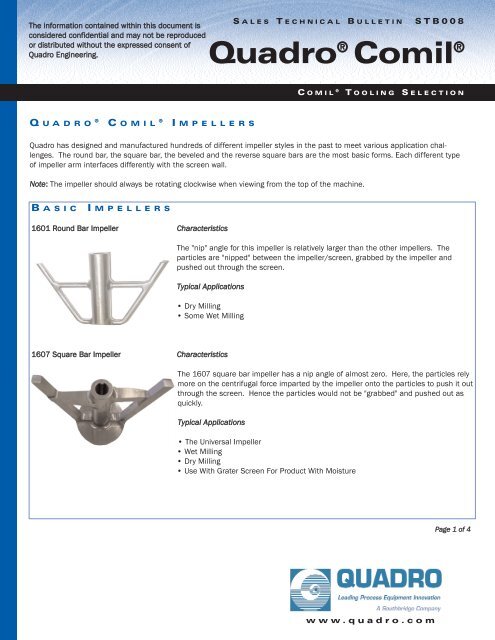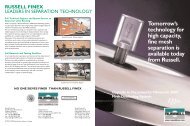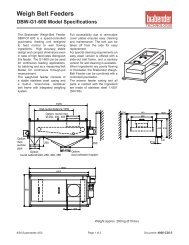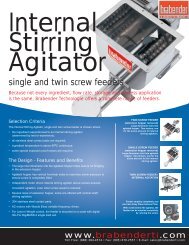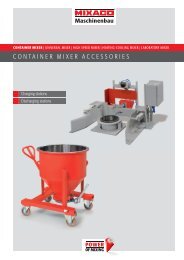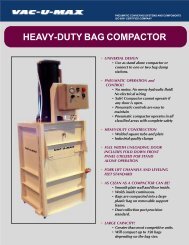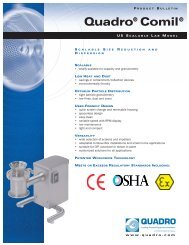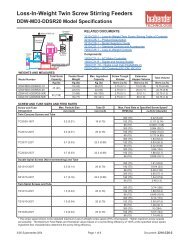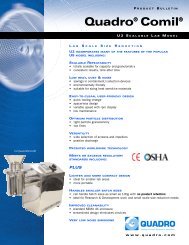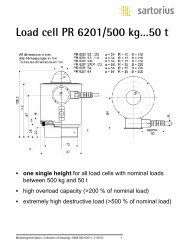Comil Tooling Select.. - Sawyer/Hanson Innovations
Comil Tooling Select.. - Sawyer/Hanson Innovations
Comil Tooling Select.. - Sawyer/Hanson Innovations
Create successful ePaper yourself
Turn your PDF publications into a flip-book with our unique Google optimized e-Paper software.
The information contained within this document is<br />
considered confidential and may not be reproduced<br />
or distributed without the expressed consent of<br />
Quadro Engineering.<br />
S ALES T ECHNICAL B ULLETIN STB008<br />
Quadro ® <strong>Comil</strong> ®<br />
C OMIL ® T OOLING S ELECTION<br />
Q UADRO ® C OMIL ® I MPELLERS<br />
Quadro has designed and manufactured hundreds of different impeller styles in the past to meet various application challenges.<br />
The round bar, the square bar, the beveled and the reverse square bars are the most basic forms. Each different type<br />
of impeller arm interfaces differently with the screen wall.<br />
Note: The impeller should always be rotating clockwise when viewing from the top of the machine.<br />
B ASIC<br />
I MPELLERS<br />
1601 Round Bar Impeller Characteristics<br />
The "nip" angle for this impeller is relatively larger than the other impellers. The<br />
particles are "nipped" between the impeller/screen, grabbed by the impeller and<br />
pushed out through the screen.<br />
Typical Applications<br />
• Dry Milling<br />
• Some Wet Milling<br />
1607 Square Bar Impeller Characteristics<br />
The 1607 square bar impeller has a nip angle of almost zero. Here, the particles rely<br />
more on the centrifugal force imparted by the impeller onto the particles to push it out<br />
through the screen. Hence the particles would not be "grabbed" and pushed out as<br />
quickly.<br />
Typical Applications<br />
• The Universal Impeller<br />
• Wet Milling<br />
• Dry Milling<br />
• Use With Grater Screen For Product With Moisture<br />
Page 1 of 4<br />
www.quadro.com
QUADRO ® COMIL ®<br />
Basic Impellers Cont’d<br />
1609 Beveled Impeller Characteristics<br />
The 1609 beveled impeller is similar to the 1607 however, it has a beveled edge<br />
where the particles can deflect back down into the screen. This "deflection" of<br />
the particles basically keeps them in the screen a little longer than if the<br />
1601 or 1607 impeller were used.<br />
Typical Applications<br />
• For Finer Grind<br />
1612 Impeller Characteristics<br />
The 1612 impeller is opposite that of the 1607. It has the highest "nip" angle and<br />
can "grab" particles and push them out through the screen, even more so than<br />
the 1601 round bar impeller.<br />
Typical Applications<br />
• For Higher Capacities<br />
H OW D O A LL T HESE A FFECT T HE M ILLING P ROCESS<br />
*<br />
*Pr. = Pressure<br />
Page 2 of 4<br />
LOCAL REPRESENTATIVE<br />
Quadro Engineering<br />
613 Colby Drive<br />
Waterloo, ON, CA N2V 1A1<br />
T 519-884-9660<br />
F 519-884-0253<br />
sales@quadro.com<br />
www.quadro.com<br />
Quadro, Inc.<br />
55 Bleeker Street<br />
Millburn, NJ, USA 07041-1414<br />
T 973-376-1266<br />
F 973-376-3363<br />
quadrosales@aol.com<br />
www.quadro.com
QUADRO ® COMIL ®<br />
How Do All These Affect The Milling Process<br />
Cont’d<br />
Capacity: The capacity would be highest for the 1612 because more particles can be "grabbed" and pushed out through the screen.<br />
The 1601 would be ranked second, the 1607 third and the 1609 fourth.<br />
Fine Generation: The 1609 will cause the particles to be retained in the screen longer, hence a higher residence time. When that<br />
happens, there will be more inter-particle attrition creating more fines. This impeller is selected when the user requires fine particles.<br />
The other impellers create less fines, as per the above noted sequence.<br />
Screen Pressure: Highest on the 1612 impeller and lowest on the 1609 impeller.<br />
Amperage Draw: Highest on the 1612 and lowest on the 1609 impeller.<br />
S CREEN<br />
S ELECTION<br />
Quadro has designed and manufactured hundreds of different types of screens but this Bulletin illustrates the few basic types.<br />
“R” Round Holed Screens: Used primarily for dry sizing or powder into liquid dispersion.<br />
Applications incude dry granulation sizing in tablet manufacturing, bakery mix fat dispersion,<br />
deagglomeration of soil, sizing and bulk density tuning of spray dried powders. Sizes range from<br />
0.006” (0.15mm) - 0.250” (6.35mm) hole diameters.<br />
“Q” Square Holed Screens: Used for wet (moist) product sizing and when larger particle sizes<br />
are required. Applications include wet granulation sizing/dispersion in tablet manufacturing, sizing<br />
moist chicken or seafood coating for reclaim, de-wrapping candy, cheese chunks and sizing<br />
centrifuge solids. Sizes range from 0.156”H X 0.156”L (3.96mmH X 3.96mmL) to 1.00”H X<br />
1.00”L (25.4mmH X 25.4mmL) hole dimensions; where “H” and “L” are the Height and Length,<br />
respectively.<br />
“S” Slotted Holed Screens: Used for breaking capsules before the “G” screen was introduced.<br />
Applications include wet granulation sizing/dispersion in tablet manufacturing, separating dried<br />
fruits such as raisins, cranberries, apricots, apples and pineapples (note, please consult Quadro<br />
for a specially designed “S” screen for these applications), breaking glass bottles/syringes for<br />
drug reclaim, sizing wet detergent lumps from cyclone wall build-up. Sizes range from 0.156”H X<br />
0.380”L (3.96mmH X 9.65mmL) to 1.00”H X 2.18”L (25.4mmH X 55.37mmL) hole dimensions;<br />
where “H” and “L” are Height and Length, respectively.<br />
Page 3 of 4<br />
LOCAL REPRESENTATIVE<br />
Quadro Engineering<br />
613 Colby Drive<br />
Waterloo, ON, CA N2V 1A1<br />
T 519-884-9660<br />
F 519-884-0253<br />
sales@quadro.com<br />
www.quadro.com<br />
Quadro, Inc.<br />
55 Bleeker Street<br />
Millburn, NJ, USA 07041-1414<br />
T 973-376-1266<br />
F 973-376-3363<br />
quadrosales@aol.com<br />
www.quadro.com
QUADRO ® COMIL ® Page 4 of 4<br />
S CREEN S ELECTION C ONT’ D<br />
“G” Grater Holed Screens: They have a cutting edge on the holes. Used for sizing products<br />
that are harder or more ductile (with some elasticity). Applications include sizing tablets in the<br />
Pharmaceutical and Nutraceutical industries, powderizing cream-filled cookies for reclaim,<br />
grating cheese, chopping nuts, sizing compacted “ribbons” from roller compactors in dry tablet<br />
manufacturing, sizing pre-compressed slugs in tablet manufacturing, sizing cereal flakes, sizing<br />
bread loaves for crumbs. This screen is often used when a tighter particle size distribution<br />
curve is desired. Sizes range rom 0.040” (1.00mm) to 1.25” (31.75mm) hole diameters.<br />
A PPARENT H OLE S IZE<br />
When selecting the proper screen hole size, the apparent<br />
hole size must be considered. What is the apparent<br />
hole size It is the size of the screen hole that is<br />
"perceived" by a particle traveling by the screen hole.<br />
At zero velocity, when a particle "looks" at a hole, it<br />
sees the actual diameter of the hole. In this slide it is<br />
labeled as D1.<br />
However, if the particle was traveling at a certain velocity,<br />
let's say "v", it will "see" the diameter of the hole as<br />
D2.<br />
“C” Condidur Holed Screens: They also have a cutting edge on the holes. It is available in<br />
smaller holed sizes when compared to the “G” screen. This allows for finer milling with less<br />
chance of screen blinding. Sizes range from 0.006” (0.15mm) to 0.039” (0.99mm) hole diameters.<br />
Other specialty screens have not been covered here. Please consult Quadro for further details and also, the Application<br />
Bulletins for more information.<br />
D1 is always greater than D2. As the velocity goes up, the apparent hole size goes down.<br />
For example, if you require a particle to be sized to 30 US Std mesh (or 0.0234"), then the screen selected should have a<br />
hole diameter of approximately 18 or 20 US Std Mesh (0.0394" or 0.0331") or larger; of course, this depends on the impeller<br />
rpm. Testing is generally recommended for proper tooling selection.<br />
LOCAL REPRESENTATIVE<br />
Quadro Engineering<br />
613 Colby Drive<br />
Waterloo, ON, CA N2V 1A1<br />
T 519-884-9660<br />
F 519-884-0253<br />
sales@quadro.com<br />
www.quadro.com<br />
Quadro, Inc.<br />
55 Bleeker Street<br />
Millburn, NJ, USA 07041-1414<br />
T 973-376-1266<br />
F 973-376-3363<br />
quadrosales@aol.com<br />
www.quadro.com


